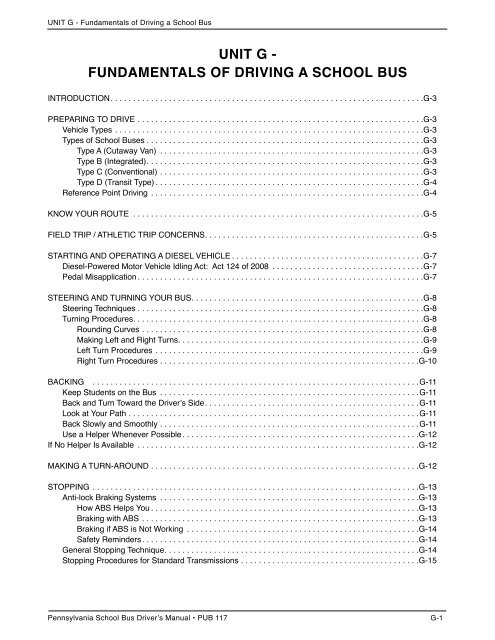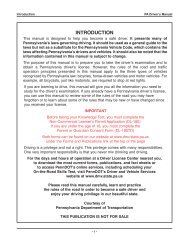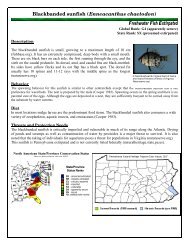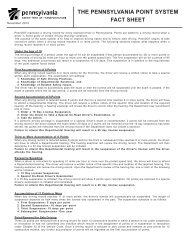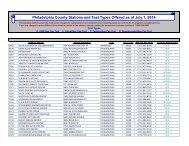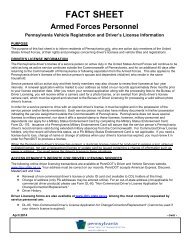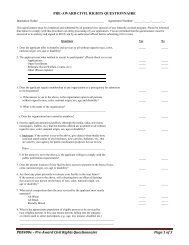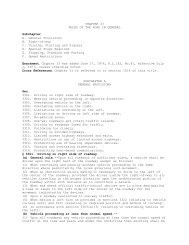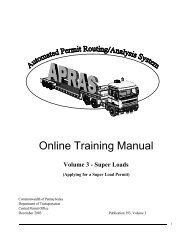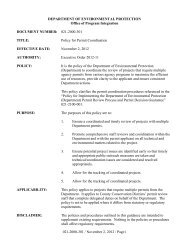fundamentals of driving a school bus - PennDOT Driver and Vehicle ...
fundamentals of driving a school bus - PennDOT Driver and Vehicle ...
fundamentals of driving a school bus - PennDOT Driver and Vehicle ...
- No tags were found...
You also want an ePaper? Increase the reach of your titles
YUMPU automatically turns print PDFs into web optimized ePapers that Google loves.
UNIT G - Fundamentals <strong>of</strong> Driving a School BusUNIT G -FUNDAMENTALS OF DRIVING A SCHOOL BUSINTRODUCTION. ..................................................................... G-3PREPARING TO DRIVE. ............................................................... G-3<strong>Vehicle</strong> Types. .................................................................... G-3Types <strong>of</strong> School Buses. ............................................................. G-3Type A (Cutaway Van) ........................................................... G-3Type B (Integrated). ............................................................. G-3Type C (Conventional). .......................................................... G-3Type D (Transit Type). ........................................................... G-4Reference Point Driving ............................................................. G-4KNOW YOUR ROUTE ................................................................. G-5FIELD TRIP / ATHLETIC TRIP CONCERNS. ................................................ G-5STARTING AND OPERATING A DIESEL VEHICLE. .......................................... G-7Diesel-Powered Motor <strong>Vehicle</strong> Idling Act: Act 124 <strong>of</strong> 2008 .................................. G-7Pedal Misapplication. ............................................................... G-7STEERING AND TURNING YOUR BUS. ................................................... G-8Steering Techniques. ............................................................... G-8Turning Procedures. ................................................................ G-8Rounding Curves. .............................................................. G-8Making Left <strong>and</strong> Right Turns. ...................................................... G-9Left Turn Procedures. ........................................................... G-9Right Turn Procedures. ......................................................... G-10BACKING ......................................................................... G-11Keep Students on the Bus .......................................................... G-11Back <strong>and</strong> Turn Toward the <strong>Driver</strong>’s Side. ............................................... G-11Look at Your Path. ................................................................ G-11Back Slowly <strong>and</strong> Smoothly. ......................................................... G-11Use a Helper Whenever Possible. .................................................... G-12If No Helper Is Available ............................................................... G-12MAKING A TURN-AROUND. ........................................................... G-12STOPPING . ........................................................................ G-13Anti-lock Braking Systems .......................................................... G-13How ABS Helps You. ........................................................... G-13Braking with ABS. ............................................................. G-13Braking if ABS is Not Working .................................................... G-14Safety Reminders. ............................................................. G-14General Stopping Technique. ........................................................ G-14Stopping Procedures for St<strong>and</strong>ard Transmissions. ....................................... G-15Pennsylvania School Bus <strong>Driver</strong>’s Manual • PUB 117 G-1
UNIT G - Fundamentals <strong>of</strong> Driving a School BusUNIT GFUNDAMENTALS OF DRIVING A SCHOOL BUSINTRODUCTIONUnit F provided you with some basic safe <strong>driving</strong> techniques for <strong>school</strong> <strong>bus</strong> operators geared towards reducingthe number <strong>of</strong> crashes related to driver error, vehicle failure <strong>and</strong> hazardous roadway conditions. As you wellknow, operating a <strong>school</strong> <strong>bus</strong> requires additional, <strong>of</strong>ten specialized knowledge <strong>and</strong> skills to transport yourstudents safely <strong>and</strong> efficiently to <strong>and</strong> from their destinations.In addition to learning a pattern <strong>of</strong> special <strong>driving</strong> skills, you must practice each skill correctly until it becomes ahabit. If you can minimize <strong>and</strong> eliminate crashes resulting from driver error, safe student transport will continueto be a hallmark <strong>of</strong> the <strong>school</strong> <strong>bus</strong> mode <strong>of</strong> transportation. The following procedures have been developed toassist you in <strong>driving</strong> a <strong>school</strong> <strong>bus</strong> safely. Remember, as a pr<strong>of</strong>essional <strong>school</strong> <strong>bus</strong> operator, you are entrustedwith the lives <strong>and</strong> safety <strong>of</strong> human cargo that cannot be measured in financial terms. Study, learn <strong>and</strong> practicethe techniques.PREPARING TO DRIVEAs mentioned in previous units, your experience in <strong>driving</strong> automobiles can provide a basis for learning to drivea <strong>school</strong> <strong>bus</strong>. However, there is a significant difference in scale. To help prepare for this, you must recognizethe differences in your vehicle <strong>and</strong> prepare to operate your vehicle BEFORE you pick up any student <strong>and</strong>remember safety is first <strong>and</strong> schedule is second.VEHICLE TYPESOne factor as to why <strong>school</strong> <strong>bus</strong>es are the safest means <strong>of</strong> ground transportation in the United States is thestringent vehicle body design <strong>and</strong> construction st<strong>and</strong>ards they are built under <strong>and</strong> must adhere to. School<strong>bus</strong>es are built so they sit above the crash line, are compartmentalized with high seat backs with padding toabsorb full body impact, <strong>and</strong> have emergency exits to provide added safety. As a <strong>school</strong> <strong>bus</strong> operator, you donot need to become an expert on the construction <strong>of</strong> the vehicle you operate, but a general working knowledge<strong>of</strong> how your <strong>bus</strong> is built <strong>and</strong> the st<strong>and</strong>ards it must meet will give you a greater underst<strong>and</strong>ing <strong>and</strong> assist you inanswering questions from the general public concerning “how safe” your passengers really are.TYPES OF SCHOOL BUSESType A (Cutaway Van)A Type A <strong>school</strong> <strong>bus</strong> is a <strong>school</strong> <strong>bus</strong> converted from or having a body constructed upon a van-type truck orfront-section vehicle chassis, with a left side driver’s door <strong>and</strong> the entrance doors behind the front wheels. Thisdefinition includes two classifications: Type A1, with a Gross <strong>Vehicle</strong> Weight Rating (GVWR) less than or equalto 10,000 pounds; <strong>and</strong> Type A2, with a GVWR greater than 10,000 pounds.Type B (Integrated)A Type B <strong>school</strong> <strong>bus</strong> is a <strong>school</strong> <strong>bus</strong> constructed utilizing a stripped chassis with the entrance door behind thefront wheels. This definition includes two classifications: Type B1, with a GVWR less than or equal to 10,000pounds; <strong>and</strong> Type B2, with a GVWR greater than 10,000 pounds.Type C (Conventional)A Type C <strong>school</strong> <strong>bus</strong> is a <strong>school</strong> <strong>bus</strong> constructed utilizing a chassis with a hood <strong>and</strong> front fender assemblywithout a left side driver’s door <strong>and</strong> with the entrance door behind the front wheels.Pennsylvania School Bus <strong>Driver</strong>’s Manual • PUB 117 G-3
UNIT G - Fundamentals <strong>of</strong> Driving a School BusType D (Transit Type)A Type D <strong>school</strong> <strong>bus</strong> is a <strong>school</strong> <strong>bus</strong> constructed utilizing a stripped chassis with the entrance door ahead <strong>of</strong>the front wheels.Most differences between automobile <strong>and</strong> <strong>bus</strong> operation are due to the relatively large size <strong>and</strong> weight <strong>of</strong> the<strong>bus</strong>. Always remember a <strong>bus</strong> has a longer stopping distance, slower acceleration, wider turning radius, <strong>and</strong>higher <strong>and</strong> wider clearances. Another difference is while <strong>school</strong> <strong>bus</strong> drivers sit higher <strong>and</strong> have a better forwardview, there is much more reliance on mirrors for adequate rear <strong>and</strong> side viewing.In preparing to drive, refer to Unit E; “Preventive Maintenance” procedures for a detailed review <strong>of</strong> the pre-tripinspection. Getting the <strong>bus</strong> ready for your daily run is an important part <strong>of</strong> safe <strong>driving</strong>. Always check yourvehicle for safety defects or problems. State law <strong>and</strong> regulation require passengers <strong>and</strong> drivers in vehiclesequipped with seat belts to wear them whenever the vehicle is in motion.In summary:• Complete your pre-trip inspection;• Adjust your mirrors;• Adjust your seat; <strong>and</strong>• Fasten your seat belt.REFERENCE POINT DRIVINGA reference point is some fixed object or point on your <strong>bus</strong> that when lined up with points outside the <strong>bus</strong> willgive you consistent reference to judge when to turn, move, stop, line up your <strong>bus</strong>, or judge the amount <strong>of</strong> spaceavailable around your <strong>bus</strong>. Any point on the <strong>bus</strong> such as the door, outside mirrors, windshield center post, <strong>bus</strong>hood, front <strong>and</strong> rear bumpers, etc., can be used as a reference point. These points are easily detectable <strong>and</strong>readily seen by you in the <strong>driving</strong> position. The distance or guidelines outside the <strong>bus</strong> are then predeterminedby direct measurement or observation before you use your <strong>bus</strong> for the first time. Once these points aredetermined <strong>and</strong> you are comfortable with the underst<strong>and</strong>ing <strong>of</strong> what each reference point is telling you, thesepoints should remain constant.Here are a few simple steps for determining reference points on your <strong>bus</strong> (get some help at first, if possible):1. Position yourself comfortably in your driver’s seat;2. Pick an easily observable point on the hood or windshield <strong>of</strong> your <strong>bus</strong>;3. With the help <strong>of</strong> someone outside your <strong>bus</strong> (if possible), on a conventional style <strong>bus</strong>, find the point onthe ground where the edge <strong>of</strong> the hood lines up with the point on the ground directly in front <strong>of</strong> it. For atransit style <strong>bus</strong>, use some point on the windshield to mark your point on the ground in front <strong>of</strong> the <strong>bus</strong>;4. Once you determine this point, note it in your mind <strong>and</strong> remember it for future reference; <strong>and</strong>5. Remember to do this in your own <strong>bus</strong>, since the point <strong>of</strong> reference may change from <strong>bus</strong> to <strong>bus</strong>depending on the height <strong>of</strong> the driver’s seat <strong>and</strong> the model <strong>of</strong> the <strong>bus</strong>.G-4 Pennsylvania School Bus <strong>Driver</strong>’s Manual • PUB 117
UNIT G - Fundamentals <strong>of</strong> Driving a School BusFor example, if the distance from your reference point to your front bumper measures 18 feet, you will knowthat whenever you are sitting in the driver’s seat, the point on the ground you see directly in front <strong>of</strong> the hood<strong>of</strong> your <strong>bus</strong> is 18 feet from the front bumper. This will be helpful for determining the proper distance to stop atrailroad grade crossings.For determining reference points to the side or rear <strong>of</strong> your <strong>bus</strong>, make sure you are seated comfortably in yourseat with seat belt attached. Then, mark points on the various outside rear view mirrors on either side <strong>of</strong> your<strong>bus</strong>.To determine the point directly below your rear bumper, use a point in your left (or right) rear view mirror thatlines up directly over the bottom <strong>of</strong> your left rear wheel well <strong>and</strong> your rear bumper. Now measure the distancefrom this point on the ground to the edge <strong>of</strong> your rear bumper. Remember this distance. You should usereference points on both left <strong>and</strong> right rear mirrors.This rear reference point can be helpful when estimating the distance from your rear bumper to some point onthe ground <strong>and</strong> can be especially helpful at a railroad grade crossing when determining the distance <strong>of</strong> yourrear bumper from the track.Finally, remember these measurements should be made <strong>and</strong> will only be applicable on level ground. Adjustyour front <strong>and</strong> rear measurements when your <strong>bus</strong> is stopped on a sloped surface.KNOW YOUR ROUTEYou’ll be more confident <strong>and</strong> be a safer driver when you become completely familiar with the route you drive.You must know what to do with hazards on your route. For example, some intersections are more hazardousdue to limited sight or an area with poor drainage that floods.Follow the local policy <strong>and</strong> procedures for reporting hazardous stops/routes. If possible, come up with asolution to the problem. Changing the <strong>bus</strong> route or <strong>bus</strong> stop location might solve the problem. The townshiproad supervisor might be able to make some changes to the roadway to correct the problem. You coulddesignate a place for your students to st<strong>and</strong> when the snow is piled up.There are some hazards that are unavoidable. By being aware <strong>of</strong> the potential hazards on your route, you willbe better prepared for the challenge.On the route schedule you keep in your <strong>bus</strong>, make notes <strong>of</strong> the route hazards, so if there is ever a substitute<strong>bus</strong> driver on your route, they will have this knowledge, too.FIELD TRIP / ATHLETIC TRIP CONCERNSField trips can present some new situations you haven’t experienced, if you are a new driver. Particularsituations that might arise could include the following:• Wondering if the <strong>bus</strong> will fit (on a street, in a parking area);• One-way streets;• Fueling;• Tolls;Pennsylvania School Bus <strong>Driver</strong>’s Manual • PUB 117 G-5
UNIT G - Fundamentals <strong>of</strong> Driving a School Bus• Parking areas;• Loading/unloading areas;• Food <strong>and</strong> rest room availability;• Security <strong>of</strong> area to park <strong>bus</strong>;• Weather;• Chaperones;• Discipline;• Medical problems <strong>and</strong> first aid;• Terrain;• Nighttime <strong>driving</strong>;• Directions;• Low clearance;• Weight limit on bridges;• Laws in other states; <strong>and</strong>• Break downs.If you are traveling out <strong>of</strong> state, make sure you have the proper credentials. This includes that you be at least21 years <strong>of</strong> age, have the U.S. DOT physical (if employed by a contractor), <strong>and</strong> carry your log book (ifapplicable).Here are some steps to help you be prepared for the field trip/athletic trip.1. Become familiar with the route.a. Look at a map, take a map with you, ask other drivers who have previously made the trip.b. Drive the route in a car prior to the trip.c. Find out if there are any detours or closed roads. You can call 511, which allows you to instantlyaccess updated road <strong>and</strong> weather conditions, traffic information, <strong>and</strong> construction reports forspecific routes, regions <strong>and</strong> cities. Also, refer to www.511pa.com.d. Plan an alternate route.2. Know where parking is <strong>and</strong> ensure it is secure.3. Have a full tank <strong>of</strong> fuel.4. Make sure you cover the emergency evacuation procedures with students <strong>and</strong> chaperones.5. Keep aisles <strong>and</strong> exits clear <strong>of</strong> baggage <strong>and</strong> equipment.6. Carry emergency phone numbers for <strong>school</strong> personnel.7. Know what to do <strong>and</strong> who to call, if you break down or have an emergency.8. Communicate with the person in charge <strong>of</strong> the trip.a. Get the name <strong>of</strong> the person in charge <strong>and</strong> their cell phone number.b. Give the person in charge your name <strong>and</strong> cell phone number.c. Agree on loading <strong>and</strong> unloading places <strong>and</strong> times.d. Make sure you <strong>and</strong> the person in charge know how to get in touch with each other.e. Make sure the person in charge knows where the <strong>bus</strong> will be parked.G-6 Pennsylvania School Bus <strong>Driver</strong>’s Manual • PUB 117
UNIT G - Fundamentals <strong>of</strong> Driving a School BusSTARTING AND OPERATING A DIESEL VEHICLEGuidelines for starting <strong>and</strong> <strong>driving</strong> your diesel <strong>bus</strong>, as well as proper gear shifting techniques are detailed inThe Commercial <strong>Driver</strong>’s Manual (Publication 223). Refer to this manual when practicing <strong>and</strong> refining yourtechniques. Keep in mind that smoothness in <strong>driving</strong> is one key to safe <strong>driving</strong> <strong>and</strong> good relations with yourstudents. Gear shifting requires knowledge, skills <strong>and</strong> practice.You must learn the best range <strong>of</strong> speed forchanging gears upward <strong>and</strong> downward, <strong>and</strong> you must shift gears without losing your view <strong>of</strong> the road. Over thecourse <strong>of</strong> your <strong>driving</strong> experiences, you may be required to shift gears in vehicles with st<strong>and</strong>ard transmissions<strong>and</strong> vehicles with automatic transmissions. No matter what transmission type you have, remember to alwaysengage your parking brake when your vehicle is not in use.DIESEL-POWERED MOTOR VEHICLE IDLING ACT: ACT 124 OF 2008Diesel vehicles are a significant source <strong>of</strong> emissions that contribute to elevated ozone <strong>and</strong> fine particulateconcentrations in Pennsylvania. Diesel exhaust from <strong>school</strong> <strong>bus</strong>es poses a health risk, particularly to children<strong>and</strong> drivers. Diesel exhaust contains small particles as well as smog-forming <strong>and</strong> toxic air pollutants. Exposureto diesel exhaust can cause lung damage <strong>and</strong> respiratory problems <strong>and</strong> can exacerbate asthma <strong>and</strong> existingallergies. Buses that idle outside <strong>school</strong>s can pollute the air inside the <strong>school</strong> building as well as outdoors.In 2008, Act 124 (Diesel-Powered Motor <strong>Vehicle</strong> Idling Act) was passed, which reduces unnecessary idling <strong>of</strong>the main propulsion engine in diesel-powered motor vehicles, including trucks <strong>and</strong> <strong>bus</strong>es. Essentially, Act 124prohibits the owners <strong>and</strong> drivers <strong>of</strong> any diesel-powered motor vehicles with a gross weight <strong>of</strong> 10,001 pounds ormore engaged in commerce from allowing the engine <strong>of</strong> the vehicle to idle for more than five minutes in anycontinuous 60-minute period. However, 35 P.S. Section 4603(c)(10) allows a <strong>school</strong> <strong>bus</strong> to idle a total <strong>of</strong> 15minutes in a continuous 60-minute period to provide heat or air conditioning to students. This section alsoallows <strong>school</strong> <strong>bus</strong>es transporting students with special needs to idle for an unlimited amount <strong>of</strong> time when it isnecessary to maintain a safe temperature.Keep in mind that while Act 124 preempts <strong>and</strong> supersedes local anti-idling ordinances or rules, more stringentidling restrictions imposed by counties <strong>of</strong> the first <strong>and</strong> second class (Allegheny <strong>and</strong> Philadelphia counties),continue in full force <strong>and</strong> effect, provided they are not amended, suspended or rendered invalid. Here are a fewgood tips:• As a general rule, <strong>bus</strong>es should be moving whenever the engine is on;• The engine should be turned <strong>of</strong>f as soon as possible after arriving at loading or unloading areas;• The <strong>school</strong> <strong>bus</strong> should not be restarted until it is ready to depart; <strong>and</strong>• Limit idling time during early morning warm up to what the manufacturer recommends (generally no morethan five minutes).PEDAL MISAPPLICATIONPedal misapplication occurs when the <strong>bus</strong> operator applies the accelerator instead <strong>of</strong> the brake. This error canresult in serious crashes. The <strong>school</strong> environment presents a unique risk with respect to unintendedacceleration from pedal misapplication. A typical loading or unloading operation at the <strong>school</strong> involves multiplevehicles <strong>and</strong> many children. Often, the children line up, wait or congregate near the <strong>bus</strong>es exposing them topossible danger. Every <strong>bus</strong> at the loading area can introduce an opportunity for pedal misapplication, <strong>and</strong> thelarge number <strong>of</strong> children represents a potential increase in the severity <strong>of</strong> the outcome should pedalmisapplication <strong>and</strong> unintended acceleration occur.Pennsylvania School Bus <strong>Driver</strong>’s Manual • PUB 117 G-7
UNIT G - Fundamentals <strong>of</strong> Driving a School BusThere are a few things you can do to help prevent pedal misapplication.1. Become familiar with your vehicle. Be sure you practice operating your <strong>bus</strong> before picking up <strong>and</strong>dropping <strong>of</strong>f students. This will give you familiarity with the location <strong>of</strong> your accelerator <strong>and</strong> brake. Thisis especially important if you are operating a <strong>bus</strong> that is not your regular <strong>bus</strong>. If you are unfamiliar withthe pedal configuration <strong>of</strong> an alternate <strong>bus</strong>, practice first.2. The National Transportation Safety Board (NTSB) recommends that at locations where you areboarding a large number <strong>of</strong> students at once (like a <strong>school</strong>), start your <strong>bus</strong> only after loading iscomplete.STEERING AND TURNING YOUR BUSYou must know the proper techniques for steering a <strong>school</strong> <strong>bus</strong> <strong>and</strong> must be able to make all turningmaneuvers correctly <strong>and</strong> smoothly.STEERING TECHNIQUESProper steering requires the proper positioning <strong>of</strong> your h<strong>and</strong>s on the steering wheel. Grip the wheel securelywith both h<strong>and</strong>s, putting your h<strong>and</strong>s on opposite sides <strong>of</strong> the wheel. For example, this may mean placing yourh<strong>and</strong>s at the ten o’clock <strong>and</strong> two o’clock positions. One h<strong>and</strong> on the wheel is less than half as safe. Your h<strong>and</strong>sshould be on the outside <strong>of</strong> the steering wheel with your thumbs on the front <strong>of</strong> the wheel.Two steering methods are recommended for <strong>school</strong> <strong>bus</strong> drivers. In the push-pull steering method, one h<strong>and</strong>pulls, <strong>and</strong> the other h<strong>and</strong> pushes. The h<strong>and</strong>-over-h<strong>and</strong> method also may be used, but you should be carefulnot to catch your thumb on the safety chain <strong>of</strong> your wristwatch, bracelet or clothing while steering. Never palmthe steering wheel or turn it with a finger or thumb. If you have to steer quickly or jerkily, you are going too fast– slow down.TURNING PROCEDURESTo drive your <strong>school</strong> <strong>bus</strong> you must use the steering techniques described above while executing a number <strong>of</strong>different turning maneuvers. These maneuvers include rounding curves, <strong>and</strong> making left <strong>and</strong> right turns. Theaverage speed limits on freeways <strong>and</strong> other roads on your route force you to use practiced skills <strong>and</strong> judgmentto perform these maneuvers properly <strong>and</strong> safely. This includes being aware <strong>of</strong> the pivot or turning point <strong>of</strong> the<strong>bus</strong> while following the various turning procedures. For large <strong>school</strong> <strong>bus</strong>es, the pivot point is located at the rearaxle. The procedures described below are applicable in most <strong>driving</strong> situations. You always need to be aware<strong>of</strong> traffic around you before you make your turn.Rounding CurvesJudge beforeh<strong>and</strong> if you will be able to negotiate an upcoming curve at your present rate <strong>of</strong> speed. If you mustbrake, do so before entering the curve. Never plan to brake in the middle <strong>of</strong> a curve as this can cause skidding<strong>and</strong> loss <strong>of</strong> control. Use the following procedures when steering through curves (see Figure G-1):1. Slow down, <strong>and</strong> look ahead for the sharpest point in the curve;2. Brake, if necessary, before getting into the curve;3. For curves to the right, move as close to the center line as is safe, <strong>and</strong> use the width <strong>of</strong> the lane whilerounding the curve. This will help to smooth out the curve;4. For curves to the left, enter the curve from the right edge <strong>of</strong> your lane; <strong>and</strong>5. When you reach the midpoint <strong>of</strong> the curve, resume power <strong>and</strong> accelerate through the remainder <strong>of</strong>the curve.G-8 Pennsylvania School Bus <strong>Driver</strong>’s Manual • PUB 117
UNIT G - Fundamentals <strong>of</strong> Driving a School BusFigure G-1. Stay in LaneAIM HIGH IN STEERINGAND SMOOTH OUTCURVES, BUT ALWAYSSTAY IN YOUROWN LANE.Making Left <strong>and</strong> Right TurnsThe procedures listed below will enable you to prepare for<strong>and</strong> make turns <strong>and</strong> to reenter the traffic pattern whilemaintaining proper lane positions. When making either aleft or right turn, start signaling at least 100 feet beforeturning, if you are travelling at speeds <strong>of</strong> 35 mph or less,<strong>and</strong> at 300 feet if you are travelling at speeds over 35 mph.(See Figures G-2 <strong>and</strong> G-3.)WHETHER MAKING A RIGHT OR LEFT TURN, BEAWARE THAT THE REAR OF YOUR BUS WILL PROJECTOUTWARD AS YOU ARE MAKING THE TURN. BECAREFUL WHEN MAKING A LEFT OR RIGHT TURNWHEN YOU ARE NEXT TO ANOTHER VEHICLE OROBJECT.Keep in mind that Pennsylvania <strong>school</strong> <strong>bus</strong> crash statistics show improper turning was indicated as the thirdmost common driver action in crashes when the <strong>school</strong> <strong>bus</strong> was the prime unit. Data also indicates that 38percent <strong>of</strong> <strong>school</strong> <strong>bus</strong> prime unit crashes were angle crashes, which most commonly occur at intersections.Left Turn ProceduresLeft turns in a <strong>school</strong> <strong>bus</strong> are generally not as difficult technique-wise to make as right turns, but they are moredangerous. Left turn collisions at intersections tend to be severe crashes. Be sure you have adequate gaps inopposing traffic to make your maneuver. Acceleration rates are different in a <strong>school</strong> <strong>bus</strong> than for a passengervehicle, <strong>and</strong> you are <strong>driving</strong> a longer vehicle.1. Get into the proper lane well in advance <strong>of</strong>Figure G-2. Left Turnsthe turn.2. Give left turn signal early (at least 100 feetaway, if you are travelling at speeds <strong>of</strong> 35mph or less, <strong>and</strong> at 300 feet, if travelling atspeeds over 35 mph).3. Reduce speed <strong>and</strong> downshift to the propergear needed to execute the turn. The speedthrough the turn will depend on the geometry<strong>of</strong> the intersection as well as trafficconditions.4. Check traffic conditions to the front, rear <strong>and</strong> sides.5. Position the <strong>bus</strong> to the left edge <strong>of</strong> the traffic lane.6. Because you do not have the right-<strong>of</strong>-way (unless at a protected left turn phase at a signalizedintersection), re-check traffic signals, signs, pedestrians, or vehicles for a clear right-<strong>of</strong>-way. Use bothoutside mirrors <strong>and</strong> check especially for vehicles attempting to pass the <strong>bus</strong> on the left side.7. If you must stop before making the turn, keep the front wheels straight <strong>and</strong> the brake pedal pressed.This stopping procedure will prevent your <strong>bus</strong> from being shoved into the path <strong>of</strong> oncoming traffic, ifyou are struck from the rear. Also, leave a space <strong>of</strong> a few feet between your <strong>bus</strong> <strong>and</strong> the vehicle infront <strong>of</strong> you. You should be able to see the rear wheels <strong>of</strong> the vehicle in front <strong>of</strong> you. If not, you are tooclose.Pennsylvania School Bus <strong>Driver</strong>’s Manual • PUB 117 G-9
UNIT G - Fundamentals <strong>of</strong> Driving a School Bus8. Check your left mirror <strong>and</strong> execute the turn smoothly without strain on the engine. Enter the highwayin the left-most lane available. If multiple left-turn lanes exist, be mindful <strong>of</strong> proper lane usage, <strong>and</strong> stayin your lane as you make the turn. Steer wheels back into position; do not let the steering wheel spinwheels back.9. After completion <strong>of</strong> turn, ensure that your turn signal is <strong>of</strong>f.10. After completing a left turn onto a multilane highway, pick up speed <strong>and</strong> move into the right lane assoon as possible.Right Turn ProceduresRight turns are more difficult because <strong>of</strong> the length <strong>of</strong> the <strong>bus</strong> <strong>and</strong> require practice. Knowing the pivot or turningpoint (located at the rear axle) <strong>of</strong> the <strong>bus</strong> is critical for right turns. This responsibility is the <strong>bus</strong> operators.For right turns:1. Get into the proper lane well in advance <strong>of</strong> the turn.2. Give right turn signal early (at least 100 feet away, if you are travelling at speeds <strong>of</strong> 35 mph or less, <strong>and</strong>at 300 feet, if travelling at speeds over 35 mph).3. Reduce speed <strong>and</strong> downshift to the proper gear needed to execute the turn. The speed through theturn will depend on the geometry <strong>of</strong> the intersection as well as traffic conditions.4. Position the <strong>bus</strong> to the right edge <strong>of</strong> the traffic lane about four feet from the curb. The <strong>bus</strong> should notbe far enough away from the curb to allow a vehicle to pass on the right between the <strong>bus</strong> <strong>and</strong> the curb.5. Check for traffic signals, signs, pedestrians, <strong>and</strong> vehicles to determine clear right-<strong>of</strong>-way. Be sure tocheck for vehicles between right side <strong>of</strong> the <strong>bus</strong> <strong>and</strong> the curb. Use your mirrors!6. Check your right mirror <strong>and</strong> execute the turn smoothly without strain on the engine. This isaccomplished as soon as the front wheels pass the corner, turn wide to the right, swinging over thecenter <strong>of</strong> the side street (if necessary) in order for the rear wheels to clear the curb. Never shift gearsduring a turn. Keep an eye on the right mirror while turning. Be mindful <strong>of</strong> any pedestrians who may best<strong>and</strong>ing at or near the curb. Also, watch out for parked cars.7. Enter the right-most lane available, but leave enough room to make your turn. If your <strong>bus</strong> must crossinto another lane in order to make the turn, make the lane crossover in the road that you are entering.8. Steer wheels back into position; do not let steering wheel spin back.9. Ensure your turn signal is <strong>of</strong>f.While Pennsylvania law allows all vehicles to makeFigure G-3. Right Turns“right turn on red,” unless otherwise designated, thismaneuver may not be recommended when operatinga <strong>school</strong> <strong>bus</strong> because <strong>of</strong> the size <strong>of</strong> the vehicle <strong>and</strong>its acceleration characteristics. Check with yourcontractor or local <strong>school</strong> district guidelines <strong>and</strong>procedures.G-10 Pennsylvania School Bus <strong>Driver</strong>’s Manual • PUB 117
UNIT G - Fundamentals <strong>of</strong> Driving a School BusBACKINGBecause you cannot see everything behind your vehicle, backing is always dangerous, even in the bestcircumstances. This is supported by Pennsylvania <strong>school</strong> <strong>bus</strong> crash data, which indicates backing is a crashcause in over 5 percent <strong>of</strong> crashes involving <strong>school</strong> <strong>bus</strong>es as the prime vehicle. This seems high consideringthe number <strong>of</strong> times backing is required, which supports the notion it is a dangerous maneuver. Pennsylvania<strong>school</strong> <strong>bus</strong> crash data shows backing crashes are four times as likely to occur in clear weather conditions asin adverse weather conditions. This may indicate drivers are complacent with this maneuver when weatherconditions are good. ANY time you have to backup, be careful <strong>and</strong> follow the recommendations below.Avoid backing whenever you can <strong>and</strong> avoid backing a <strong>bus</strong> from a side road to a main road. Unfortunately, theremay be situations where backing is necessary, such as when you are at the end <strong>of</strong> your route <strong>and</strong> there is nobetter designated turn around area, or if you get lost on a road <strong>and</strong> encounter a bridge weight limit. If you know<strong>of</strong> a better area to turn around that would avoid backing, talk to your transportation coordinator about modifyingyour route.School <strong>bus</strong>es are also most <strong>of</strong>ten parked by backing into their location. When you park, try to park, so you willbe able to pull forward when you leave. When you have to back, follow these rules:1. Keep Students on the Bus – Keep all students on the <strong>bus</strong>. State regulation (Section 104.3(d) <strong>of</strong>Title 67) requires that if backing is required at or near a loading or unloading zone, all students must beseated on the <strong>bus</strong> during the backing. Never back a <strong>bus</strong> when students are outside, so either back upbefore drop-<strong>of</strong>f or after-pick up. Be particularly aware <strong>of</strong> students who may be late <strong>and</strong> running to catchthe <strong>bus</strong>.2. Back <strong>and</strong> Turn Toward the <strong>Driver</strong>’s Side – Plan your maneuver. Whenever possible, back towardthe driver’s side, so you can see better. Backing toward the right side is very dangerous because youcan’t see as well. If you back <strong>and</strong> turn toward the driver’s side, you can watch the rear <strong>of</strong> your vehicleby looking out the side window <strong>and</strong> in the mirror.When backing a <strong>bus</strong>, turn the top <strong>of</strong> the steering wheel toward the direction you want to go. This may takepractice.3. Look at Your Path – Look at your line <strong>of</strong> travel to be sure you know what is behind you before youbegin. Don’t take chances. Sometimes you can’t see enough with your mirrors; it’s much safer to getout <strong>and</strong> look, even if it means walking to the rear <strong>of</strong> the <strong>bus</strong> to determine whether the way is clear. Byso doing, you may prevent a serious incident. If you need to walk to the rear <strong>of</strong> the <strong>bus</strong>, set the parkingbrake, turn <strong>of</strong>f the motor <strong>and</strong> take the keys with you. Walk to the rear <strong>of</strong> the <strong>bus</strong> to determine whetherthe way is clear. Also check your clearance to the sides <strong>and</strong> overhead both in <strong>and</strong> near the path yourvehicle will take. Then reenter the vehicle, check your mirrors <strong>and</strong> start backing.4. Back Slowly <strong>and</strong> Smoothly – Always back as slowly as possible so you may make correctionsbefore you get too far <strong>of</strong>f course. Go slowly, so you can correct any steering errors more easily beforeyou get too far <strong>of</strong>f course. Going slowly means you can also stop quickly, if necessary.Pennsylvania School Bus <strong>Driver</strong>’s Manual • PUB 117 G-11
UNIT G - Fundamentals <strong>of</strong> Driving a School Bus5. Use a Helper Whenever Possible – If possible, have an adult (not a student) stationed on thedriver’s side rear <strong>of</strong> the <strong>bus</strong>, so you can see him/her at all times in your mirror to warn traffic <strong>and</strong> act asyour guide. If a helper is available:• Agree on h<strong>and</strong> signals ahead <strong>of</strong> time, especially “Stop”;• Position the helper out <strong>of</strong> the travel path, so you can see the helper <strong>and</strong> the helper can see the path<strong>of</strong> travel;• Back slowly; <strong>and</strong>• Stop immediately, if you lose sight <strong>of</strong> your helper.Verbally communicate with the helper before you begin <strong>and</strong> while backing.6. If No Adult Helper is Available – It may be necessary to use portable emergency warning devices toblock <strong>of</strong>f the lane <strong>of</strong> traffic the vehicle is backing into. Use the following procedure:a. Stop the <strong>bus</strong> in the correct position to back <strong>and</strong> activate the four-way hazard warning lights. If the <strong>bus</strong>does not have automatic back-up signals, use the horn. Remember, approaching traffic may not knowyou are backing, so using the four-way hazard lights <strong>and</strong> blowing the horn will help alert them to yourmaneuver;b. Signal for quiet on the <strong>bus</strong>;c. Using mirrors, ensure the way is clear to the rear <strong>and</strong> sides;d. Put transmission in reverse; <strong>and</strong>e. Using mirrors, back slowly <strong>and</strong> smoothly.MAKING A TURN-AROUNDMost <strong>bus</strong> routes are planned to eliminate turn-arounds <strong>and</strong> backing because they are extremely hazardousmaneuvers. Unfortunately, there may be situations where turning around is necessary. Much like with backing,if you must turn your <strong>bus</strong> around at a loading zone, always load passengers being picked up before making theturn-around, <strong>and</strong> always unload passengers being discharged after making the turn-around. If at all possible,make a turn-around in twilight or darkness when an adult helper is present to stop traffic on any roadway usedfor the maneuver.Figure G-4. Turn-AroundsBecause backing the <strong>bus</strong> is an extremelydangerous procedure, the safest way to turnaround is to avoid backing <strong>and</strong> use a forwardturn-around. Ideally, a turn-around should bemade by selecting an adequately sized, safearea away from the road, such as a parkinglot, where you can slowly move the <strong>bus</strong>forward in a wide circle to turn around.Otherwise, a turn-around should be made inthe following manner (see Figure G-4):1. Activate the four-way hazard warning lights at least 200 feet before your stopping point;2. Stop the <strong>bus</strong> in the proper position on the highway, which is one full <strong>bus</strong> length ahead <strong>of</strong> the area intowhich you are backing;G-12 Pennsylvania School Bus <strong>Driver</strong>’s Manual • PUB 117
UNIT G - Fundamentals <strong>of</strong> Driving a School Bus3. Check traffic to the front <strong>and</strong> rear, as well as roadside obstacles such as poles, trees, mailboxes <strong>and</strong>culverts. Clearance on all sides <strong>of</strong> the <strong>bus</strong> is important. You should have traffic visibility for at least500 feet in either direction;4. Use all mirrors <strong>and</strong> look carefully in all directions to observe traffic <strong>and</strong> obstacles, back slowly <strong>and</strong>cautiously into the designated area (see backing information above); <strong>and</strong>5. Make sure to check traffic both ways, reenter the highway, deactivate the hazard warning lights, <strong>and</strong>proceed with extreme caution.STOPPINGUnit F included detailed information on stopping requirements for <strong>school</strong> <strong>bus</strong>es. Stopping a <strong>school</strong> <strong>bus</strong>smoothly <strong>and</strong> within the limits <strong>of</strong> safety is the sign <strong>of</strong> an expert driver. Good drivers have their vehicles undercontrol at all times <strong>and</strong> know braking distances increase greatly as speed <strong>and</strong> vehicle weight increase. Inaddition to knowing the distance required to safely stop their <strong>bus</strong> under all <strong>driving</strong> conditions, skillful driversuse correct stopping procedures, which increase <strong>bus</strong> life <strong>and</strong> lower maintenance costs.Anti-lock Braking SystemsThe U.S. DOT requires that anti-lock braking systems be on air brakes vehicles, (trucks, <strong>bus</strong>es, trailers, etc.)built on or after March 1, 1998 <strong>and</strong> hydraulically braked trucks <strong>and</strong> <strong>bus</strong>es with a gross vehicle weight rating <strong>of</strong>10,000 lbs or more built on or after March 1, 1999. Many <strong>bus</strong>es built before these dates have been voluntarilyequipped with ABS. Your <strong>school</strong> <strong>bus</strong> will have a yellow ABS malfunction lamp on the instrument panel, if it isequipped with ABS.How ABS Helps YouWhen you brake hard on slippery surfaces in a vehicle without ABS, your wheels may lock up. When your frontsteering wheels lock up, you lose steering control. When your other wheels lock up, you may skid or even spinthe vehicle. ABS helps you avoid wheel lock up <strong>and</strong> maintain control. You may or may not be able to stop fasterwith ABS, but you should be able to steer around an obstacle while braking, <strong>and</strong> avoid skids caused by overbraking.Braking With ABSABS is designed to help the driver maintain control <strong>of</strong> the <strong>bus</strong> during emergency braking situations, not makethe <strong>bus</strong> stop more quickly. ABS may shorten stopping distances on wet or slippery roads, <strong>and</strong> many systemswill shorten stopping distances on dry roads. On very s<strong>of</strong>t surfaces, such as loose gravel or unpacked snow,an ABS system may actually lengthen stopping distances. In wet or slippery conditions, you should still makesure you drive carefully, always keep a safe distance behind the vehicle in front <strong>of</strong> you, <strong>and</strong> maintain a speedconsistent with the road conditions.When you drive a vehicle with ABS, you should brake as you always have. In other words:• Use only the braking force necessary to stop safely <strong>and</strong> stay in control; <strong>and</strong>• Brake the same way, regardless <strong>of</strong> whether you have ABS on the <strong>bus</strong>.However, in emergency braking, do not pump the brakes on a <strong>bus</strong> with ABS.As you slow down, monitor your <strong>bus</strong> <strong>and</strong> back <strong>of</strong>f <strong>of</strong> the brakes (if it is safe to do so) to stay in control.Pennsylvania School Bus <strong>Driver</strong>’s Manual • PUB 117 G-13
UNIT G - Fundamentals <strong>of</strong> Driving a School BusBraking if ABS is Not WorkingWithout ABS, you still have normal brake functions. Drive <strong>and</strong> brake as you always have. <strong>Vehicle</strong>s with ABShave yellow malfunction lamps to tell you if something is not working. The yellow ABS malfunction lamp is onthe <strong>bus</strong>’s instrument panel. As a system check on newer vehicles, the malfunction lamp comes on at start-upfor a bulb check <strong>and</strong> then goes out quickly. On older systems, the lamp could stay on until you are <strong>driving</strong> overfive mph. If the lamp stays on after the bulb check, or goes on once you are under way, you may have lost ABScontrol at one or more wheels. Remember, if your ABS malfunctions, you still have regular brakes. Drivenormally, but get the system serviced soon.Safety Reminders• ABS does not compensate for bad <strong>driving</strong> habits, such as <strong>driving</strong> too fast, following too closely or <strong>driving</strong>less carefully;• ABS won’t prevent power or turning skids – ABS should prevent brake-induced skids, but not thosecaused by spinning the drive wheels or going too fast in a turn;• ABS won’t necessarily shorten stopping distance. ABS will help maintain vehicle control, but not alwaysshorten stopping distance;• ABS won’t increase or decrease ultimate stopping power – ABS is an “add-on” to your normal brakes, nota replacement for them;• ABS won’t change the way you normally brake. Under normal brake conditions, your vehicle will stop asit always stopped. ABS only comes into play when a wheel would normally have locked up because <strong>of</strong>over-braking; <strong>and</strong>• ABS won’t compensate for bad brakes or poor brake maintenance.Remember: The best vehicle safety feature is still a safe driver.Remember: Drive so you never need to use your ABS.Remember: If you need it, ABS could help to prevent a serious crash.Remember: If your <strong>bus</strong> is equipped with ABS, do not pump the brakes in emergency situations.GENERAL STOPPING TECHNIQUEUse the right foot for all normal braking. A <strong>school</strong> <strong>bus</strong> is much heavier than smaller vehicles <strong>and</strong> requires thedriver to begin braking sooner in order to stop smoothly. Feather the brake by reducing pressure on the brakepedal slightly just before the wheels stop rolling. This creates a smoother stop <strong>and</strong> happier passengers. A gooddriver anticipates stops as much as possible. This increases the margin <strong>of</strong> safety <strong>and</strong> helps save brake shoes.Avoid sudden stops.G-14 Pennsylvania School Bus <strong>Driver</strong>’s Manual • PUB 117
UNIT G - Fundamentals <strong>of</strong> Driving a School BusSTOPPING PROCEDURES FOR STANDARD TRANSMISSIONSDifferent procedures are required for stopping at low <strong>and</strong> high speeds or on an upgrade or downgrade. If youstop the <strong>bus</strong> for more than several minutes in a non-traffic situation, turn <strong>of</strong>f the engine. This not only conservesfuel, but eliminates the possibility <strong>of</strong> poisonous carbon monoxide exhaust fumes entering the <strong>bus</strong>.Low Speed StoppingWhen you are in a low gear or are traveling 10 mph or less, use the following stopping procedures:1. Release the accelerator <strong>and</strong> when speed decreases to 3 to 5 mph, press the clutch pedal;2. Apply the brakes gradually by increasing pressure;3. To prevent the <strong>bus</strong> from jerking, reduce the brake pressure slightly, but not completely just beforecoming to a stop;4. Place the gear shift lever into the neutral position; <strong>and</strong>5. Release the clutch <strong>and</strong> remove foot from the clutch.Stopping at Speeds Greater than 10 MPHWhen traveling in a higher gear, the procedure for stopping is as follows:1. Release the accelerator <strong>and</strong> press the brake pedal;2. When you reach the minimum speed for the next lower gear, downshift to that gear. Using the lowergear will reduce the buildup <strong>of</strong> heat <strong>and</strong> avoid excessive brake wear. This is also the case for automatictransmissions; <strong>and</strong>3. Downshifting can be very effective <strong>and</strong> smooth if you use third gear for the slowing action in five-speedtransmissions, <strong>and</strong> second gear in four-speed transmissions.Stopping on an UpgradeWhen coming to a stop on an upgrade, you should:1. Be aware <strong>of</strong> the traffic behind you;2. Apply pressure on the foot brake lightly for a smooth stop;3. Press clutch with left foot; shift into neutral;4. Hold <strong>bus</strong> with h<strong>and</strong> brake, if necessary. Don’t use the clutch as a brake; <strong>and</strong>5. Allow an extra safety margin <strong>of</strong> space between the <strong>bus</strong> <strong>and</strong> the vehicle ahead.Stopping on a DowngradeWhen coming to a stop on a downgrade, stop as you would on an upgrade, except downshift to reduce speedas necessary. If the downgrade is quite long <strong>and</strong>/or steep, use the “snub” braking technique discussed later inthis unit.CHECKING OVERHEAD CLEARANCEHitting overhead objects is a danger. A typical <strong>school</strong> <strong>bus</strong> is not more than 12 feet in height, so make sure youalways have enough room overhead. This not only includes on-the-road hazards, such as low hanging wires,overhanging branches, etc., but overhead hazards in your <strong>bus</strong> storage location such as wash bays <strong>and</strong> garageentrances. The clearance requirement for wires over a roadway is 18 feet, but over driveways is only 15 feet.This is a significant difference <strong>and</strong> one to be aware <strong>of</strong> if you have to turn a <strong>bus</strong> around, especially if the wiresappear to be hanging low.Pennsylvania School Bus <strong>Driver</strong>’s Manual • PUB 117 G-15
UNIT G - Fundamentals <strong>of</strong> Driving a School BusA few other points to keep in mind:• If you aren’t sure you have safe space to pass under an object, go slowly <strong>and</strong> watch carefully. This willallow you to stop, if you cannot make it. If you doubt you can make it, take another route. Pay attention towarnings posted in advance <strong>of</strong> <strong>and</strong> on low bridges or underpasses. These should be posted where thevertical clearance is less than 14’6 feet. A typical <strong>school</strong> <strong>bus</strong> is not more than 12 feet in height, so payattention.• Don’t assume the heights posted at bridges <strong>and</strong> overpasses are correct. Repaving or packed snow mayhave reduced clearances since heights were posted.• Some roads are narrow <strong>and</strong> are crowned such that it can cause a vehicle to tilt. This may result inproblems for the <strong>bus</strong> clearing objects along the edge <strong>of</strong> the road, such as signs or trees. Where this is aproblem, drive a little closer to the center <strong>of</strong> the road as long as you keep adequate side clearance fromthe center <strong>of</strong> the road. You do not want to sideswipe a vehicle travelling in the opposite direction with yourmirrors or <strong>bus</strong> body.• If you have to turn a <strong>bus</strong> around <strong>and</strong> back into an area, get out <strong>and</strong> check for overhanging objects, suchas trees, branches or electric wires. It’s easy to miss seeing them while you are backing. Also check forother hazards like culverts or mailboxes at the same time. Remember to turn <strong>of</strong>f the <strong>bus</strong> <strong>and</strong> remove thekeys from ignition, if students are on board.• If you notice low overhanging branches along your route, consider reporting them to your supervisor whocan notify the proper entity responsible for removing them. This can be important, especially with deadlimbs overhanging the route, which are typically the ones to fall on the roadway after the first snow/icestorm.• Know the height <strong>of</strong> your vehicle, including ro<strong>of</strong> hatches <strong>and</strong> strobe lights.APPROACHING RAILROAD CROSSINGSCrossing railroad tracks represents one <strong>of</strong> the greatest hazards in terms <strong>of</strong> mass injuries <strong>and</strong> fatalities forstudents riding in <strong>school</strong> <strong>bus</strong>es. Planned safety procedures for vehicles crossing railroad tracks can helpeliminate these crashes. Practice the procedures discussed below until they become automatic actions. At thesame time, don’t let repetition create a false sense <strong>of</strong> security.Trains cannot stop quickly as its response is limited by its size, weight <strong>and</strong> the engineer’s view down the track.A train cannot swerve to avoid a <strong>school</strong> <strong>bus</strong>. Also, due to their large size, trains appear to be moving moreslowly than their actual speed. <strong>Driver</strong>s <strong>of</strong>ten mistakenly judge they have enough time to safely cross before thetrain reaches the crossing. Be aware <strong>of</strong> this fact <strong>and</strong>, whenever in doubt, wait for the train to pass. You have anumber <strong>of</strong> young lives depending on you; always use extra caution when making decisions at railroadcrossings.WHEN A BUS MUST STOP AT A RAILROAD CROSSINGState law (Section 3342 <strong>of</strong> Title 75, the PA <strong>Vehicle</strong> Code) requires all <strong>school</strong> <strong>bus</strong>es, whether carryingpassengers, to stop at all railroad crossings. The exceptions are:• Crossings controlled by a police <strong>of</strong>ficer or flagman;• Crossings regulated by a functioning highway traffic control signal transmitting a green light;• Any crossing marked by the former rail operator with a “tracks out <strong>of</strong> service” sign; <strong>and</strong>• An industrial or spur line crossing marked with an “exempt” sign.G-16 Pennsylvania School Bus <strong>Driver</strong>’s Manual • PUB 117
UNIT G - Fundamentals <strong>of</strong> Driving a School BusPROCEDURES FOR STOPPING AT A RAILROAD CROSSINGWhen you must stop your <strong>bus</strong> at a railroad crossing, Pennsylvania regulations (Section 71.4(2)(ii)(B) <strong>of</strong> Title67) require you to always follow these procedures:1. When approaching, activate 4-way hazard lights;2. Stop between 15 <strong>and</strong> 50 feet from nearest the rail;3. Apply parking brake, transmission in neutral;4. Open door <strong>and</strong> window;5. Look <strong>and</strong> listen;6. Close door;7. If clear, put in gear <strong>and</strong> release parking brake;8. Proceed across tracks without shifting gears; <strong>and</strong>9. Deactivate four-way hazard lights after crossing tracks.What follows is a more detailed discussion <strong>of</strong> these steps.Prepare to Stop1. Request complete silence from passengers, so you have minimal distractions. If necessary, turn <strong>of</strong>fheaters to further reduce noise;2. Turn <strong>of</strong>f any AM-FM, 2-way or CB radios, or any other noise emitting devices not necessary for thesafe operation <strong>of</strong> the <strong>bus</strong>;3. As you approach, get the big picture: check traffic control devices; visibility <strong>of</strong> the crossing, tracks,terrain, <strong>and</strong> roadways on either side <strong>of</strong> the tracks; volume, type, <strong>and</strong> position <strong>of</strong> other traffic; sightdistance down the tracks; <strong>and</strong> the amount <strong>of</strong> space on the other side <strong>of</strong> the track should you have tostop your vehicle shortly after crossing the track; <strong>and</strong>4. Activate four-way hazard lights 100 to 200 feet in advance <strong>of</strong> the tracks.Stop the Bus1. Follow stopping procedures described earlier in this unit;2. Stop in a position permitting you to have a clear view <strong>of</strong> the tracks in both directions. The front bumpermust be clear <strong>of</strong> tracks, at least 15 feet away <strong>and</strong> at most 50 feet away from the nearest rail;3. Pull up, so you can see the tracks in both directions, if needed;4. Remember to allow extra distance at any railroad grade crossing since trains overlap the track byabout three feet.5. Apply the parking (emergency) brake <strong>and</strong> shift into neutral.Look <strong>and</strong> Listen1. Open service door <strong>and</strong> driver’s window; make sure that you do not activate the eight-way light system;2. Turn <strong>of</strong>f any AM-FM, 2-way or CB radios, or any other noise emitting devices not necessary for thesafe operation <strong>of</strong> the <strong>bus</strong>;3. Look <strong>and</strong> listen through the open door <strong>and</strong> window; <strong>and</strong>4. Never leave a <strong>bus</strong> to check for a train.Pennsylvania School Bus <strong>Driver</strong>’s Manual • PUB 117 G-17
UNIT G - Fundamentals <strong>of</strong> Driving a School BusNo Approaching TrainIf you see <strong>and</strong> hear no signs <strong>of</strong> an approaching train, do the following:1. Close service door;2. Put the <strong>bus</strong> in low gear <strong>and</strong> release the parking (emergency) brake;3. Look <strong>and</strong> listen a second time;4. If clear, proceed across the track without shifting gears; <strong>and</strong>5. Deactivate four-way hazard lights after clearing the tracks.Approaching TrainA train cannot stop quickly. Trains always appear to be moving slower than they actually are. Follow theseprocedures when a train is approaching the crossing:1. Hold <strong>bus</strong> in position <strong>and</strong> use the parking (emergency) brake;2. After the train passes, proceed across the tracks as described above.Multi-Track CrossingsAt crossings with more than one set <strong>of</strong> tracks, do the following:1. Check the crossbuck for a sign indicating the number <strong>of</strong> tracks at the crossing, if there is more thanone;2. Make sure no train is approaching on any <strong>of</strong> the tracks;3. Only make one stop – not one stop per track; <strong>and</strong>4. After a train passes, wait until other tracks become visible before proceeding. A second train may beapproaching from the opposite direction.OTHER POINTERS FOR DEALING WITH RAILROAD CROSSINGSHere are a few additional safety tips to learn when <strong>driving</strong> over railroad grade crossings:1. Learn about the various types <strong>of</strong> highway/rail grade crossing warning devices. Not only are you riskingarrest, if you fail to respond properly to these devices, you are risking your life <strong>and</strong> the lives <strong>of</strong> yourpassengers. For example,a. The “crossbuck” is a passive or “non-active” signFigure G-5. Railroad Crossbuckidentifying a rail crossing. Always use extreme cautionwhen passing over a crossing. You may proceedacross a railroad highway/rail grade crossing only aftera train has passed <strong>and</strong>/or you determine no train isapproaching.b. At multiple-track crossings, the number <strong>of</strong> sets <strong>of</strong> tracksgoverned by the crossing device is indicated by anumber under the cross buck sign. If there are multipletracks, there will be a number to indicate how many sets<strong>of</strong> tracks will be crossed.G-18 Pennsylvania School Bus <strong>Driver</strong>’s Manual • PUB 117
UNIT G - Fundamentals <strong>of</strong> Driving a School Bus2. REMEMBER, no person shall drive any vehicle through, around or under any crossing gate or barrierat a railroad crossing while such gate or barrier is closed or is being opened or closed. If you encountera situation where an automatic flashing light signal with gate is operating <strong>and</strong> no train has arrived afteran extended period <strong>of</strong> time, report the lowered gate immediately, check for an alternate route or waitfor assistance. No student can exit the <strong>bus</strong> to lift the gate.3. Always follow directions <strong>of</strong> a police <strong>of</strong>ficer or flag person directing traffic at any highway/rail gradecrossing.4. Cross the tracks only after the train has cleared a position to cancel any warning devices activated, orat crossings with no automatic warning devices.5. The drivers <strong>of</strong> manual transmission <strong>bus</strong>es should place the gear in low starting gear. The driver shouldclose the service door, look again in both directions, check for flashing signal lights, <strong>and</strong> then proceedacross the tracks without stopping or changing gears.6. The drivers <strong>of</strong> automatic transmission <strong>bus</strong>es should proceed over the tracks using the normal <strong>driving</strong>gear. A good rule <strong>of</strong> thumb is to proceed in the lowest gear until you are clear <strong>of</strong> the tracks. Thisprevents the gear from changing while crossing the tracks.7. Never drive onto a railroad track until you are certain there is adequate room ahead for your ENTIREvehicle to clear the tracks completely. Know the length <strong>of</strong> your <strong>bus</strong>. It can be life threatening to beginto cross a set <strong>of</strong> tracks only to find you must stop your vehicle for traffic before you have completelycleared the tracks.8. Never stop <strong>and</strong> backup the <strong>bus</strong> while crossing the tracks.9. Hazard lights need to be activated approximately between 100 <strong>and</strong> 200 feet before <strong>and</strong> after stoppingat the highway/rail grade crossing. Cancel your hazard lights when you have completely cleared thetracks, <strong>and</strong> your vehicle has traveled at least 100 feet from the tracks.If for any reason your <strong>bus</strong> should become stalled on the tracks <strong>and</strong> a train is approaching, IMMEDIATELYEVACUATE your <strong>bus</strong>. The quickest method <strong>of</strong> evacuation would be the front- <strong>and</strong> rear-door method. The drivershould assign a responsible student in each group to keep the children together. The driver must be able to seeboth groups <strong>of</strong> children. Students should be instructed to move away from the <strong>bus</strong> in a direction toward thetrain, but at a right angle to the train. (This is important, since upon impact, the <strong>bus</strong> <strong>and</strong> debris will be pusheddown the track.) If the <strong>bus</strong> is stalled on the tracks <strong>and</strong> no train is in sight, the driver should evacuate thechildren from the front or back <strong>of</strong> the <strong>bus</strong>. The children should move to a safe place at least 200 feet away fromthe <strong>bus</strong>. They must not cross the tracks. All evacuation procedures need to be cleared by the district personnel.CROSSING DRAWBRIDGESSchool <strong>bus</strong>es are required to stop at drawbridges without a signal light or traffic control attendant at the gate.Stop at least 50 feet before the draw <strong>of</strong> the bridge. Look to make sure the draw is completely closed beforecrossing. After stopping, proceed when it is safe to do so. It is recommended you cross in low gear, so therewill be no necessity for changing gears while traversing the drawbridge. Therefore, like railroad crossings, donot shift gears while crossing the draw span <strong>of</strong> any draw bridge.You do not need to stop, but you must slow down <strong>and</strong> make sure it’s safe when:• A traffic light on the bridge is showing green; <strong>and</strong>• The bridge has an attendant or traffic <strong>of</strong>ficer who controls traffic whenever the bridge opens.Pennsylvania School Bus <strong>Driver</strong>’s Manual • PUB 117 G-19
UNIT G - Fundamentals <strong>of</strong> Driving a School BusENTERING AND EXITING THE FLOW OF TRAFFICWhile <strong>driving</strong>, you will frequently leave one traffic stream <strong>and</strong> become part <strong>of</strong> another or cross through asecond stream <strong>of</strong> traffic. This may occur at intersections, or even simply picking up or discharging yourstudents. In many cases, your vehicle movements will be regulated by traffic signs or signals. In other cases,the merging points will be controlled by your good judgment.GENERALObserve the following procedures when entering the flow <strong>of</strong> traffic:1. Turn on the appropriate turn signal well before the point <strong>of</strong> entry;2. If appropriate, stop just before the point <strong>of</strong> entry. In many cases you will already be stopped. If you areon a freeway acceleration lane marked with a yield sign, see the next section on ramps;3. Check your mirror to ensure all passengers are seated;4. Ensure no pedestrians are in the path <strong>of</strong> the <strong>bus</strong>;5. Look left <strong>and</strong> right to see if there are any moving vehicles on the road you will enter;6. Check all mirrors for clear space around the <strong>bus</strong> including behind you. If necessary, turn your head tocheck blind spots;7. Yield the right-<strong>of</strong>-way to vehicles already on the road;8. Look for a suitable gap in traffic <strong>and</strong>, with reasonable safety, accelerate smoothly into the roadway asquickly as possible; <strong>and</strong>9. Turn <strong>of</strong>f the turn signal after you are safely in your lane.Observe the following procedures when exiting the flow <strong>of</strong> traffic:1. Turn on the appropriate turn signal well before the point <strong>of</strong> exit;2. Look left <strong>and</strong> right to see if there are any moving vehicles on the road you will be merging onto,especially if it is a deceleration lane;3. Check all mirrors for clear space around the <strong>bus</strong>, including behind you. If necessary, turn your head tocheck blind spots;4. Decelerate smoothly <strong>and</strong>, remember, <strong>school</strong> <strong>bus</strong>es will take longer to stop; <strong>and</strong>5. Turn <strong>of</strong>f the turn signal after you have safely exited.ENTRANCE AND EXIT RAMPSObserve the following procedures when <strong>driving</strong> on entrance or exit ramps. A <strong>school</strong> <strong>bus</strong> is slower to respondto changes in acceleration <strong>and</strong> deceleration, so you will need to adjust your <strong>driving</strong> habits accordingly. Enter orexit the expressway as safely <strong>and</strong> quickly as possible while accelerating or decelerating to the flow <strong>of</strong> traffic asneeded.1. Check <strong>and</strong> re-check the traffic ahead when entering the <strong>driving</strong> lane on an entrance ramp. Lookspecifically for vehicles stopped or slowing down.2. When <strong>driving</strong> on a long entrance ramp with an acceleration lane marked with a yield sign, check thetraffic ahead, <strong>and</strong>, if possible, allow the vehicles ahead to leave the acceleration lane before attemptingto merge into the roadway. Use the acceleration lane to match speed with the main stream <strong>of</strong> trafficbefore entering a suitable gap.3. Always use turn signals when merging.G-20 Pennsylvania School Bus <strong>Driver</strong>’s Manual • PUB 117
UNIT G - Fundamentals <strong>of</strong> Driving a School Bus4. If you are entering the main roadway from an entrance ramp without an acceleration lane or one with astop control, stop before merging. Through the side window, observe the main stream <strong>of</strong> traffic <strong>and</strong> donot proceed until you detect a gap large enough for accelerating <strong>and</strong> merging safely <strong>and</strong> smoothly.5. When approaching <strong>and</strong> entering an exit ramp, observe the speed <strong>of</strong> traffic <strong>and</strong> adjust your speedappropriately. Remember, posted speed limits for <strong>of</strong>f ramps <strong>and</strong> on ramps are for automobiles, but maynot be safe for larger vehicles. Watch for other vehicles that may be stopped or waiting in line at theend <strong>of</strong> the exit ramp.6. Be prepared to stop.USING LANES AND POSITIONING ON THE HIGHWAYChanging lanes, being passed by other vehicles, <strong>and</strong> passing other vehicles are maneuvers you will execute<strong>of</strong>ten while <strong>driving</strong> a <strong>school</strong> <strong>bus</strong>. The size <strong>of</strong> a <strong>school</strong> <strong>bus</strong> <strong>and</strong> the safety <strong>of</strong> your passengers require the use<strong>of</strong> proper procedures when executing these maneuvers.GENERALFollow these procedures:• Always drive in the lane <strong>of</strong> traffic giving you the best maneuverability for your route (especially whenmaking turns) <strong>and</strong> allows you the best defensive position for weather, traffic, <strong>and</strong> road conditions;• Stay within one lane for normal <strong>driving</strong>; do not straddle lane markers;• To maintain proper lane position, get the “big picture” <strong>of</strong> the road ahead. Always aim high in steering; don’tuse white lines or other steering guides too close to the <strong>bus</strong>. Activate your four-way hazard warning lightswhen your speed is below the posted speed on open highways;• Use parking lane for stopping <strong>and</strong> parking only;• Where there is more than one lane for traffic in the same direction, travel in the right-most lane unless youintend to pass or turn left. Do not drive in the parking lane; <strong>and</strong>• Drive at a safe following distance from other vehicles. A discussion <strong>of</strong> safe following distances can befound earlier in this unit.CHANGING LANESWhen you drive a <strong>school</strong> <strong>bus</strong> in an urban/suburban area, you may have to change lanes frequently. Changinglanes with a <strong>school</strong> <strong>bus</strong> requires greater concentration <strong>and</strong> more careful use <strong>of</strong> mirrors than changing laneswith a car. If a lane change is necessary, always use extreme care.On highways <strong>and</strong> streets with multiple lanes <strong>of</strong> traffic in the same direction, use these procedures to changelanes:• When changing lanes, always signal your intention to change lanes with your turn signal. You mustalways use your turn signals at least 100 feet before turning, if you are <strong>driving</strong> less than 35 mph. If youare <strong>driving</strong> 35 mph or more, you must signal at least 300 feet before turning. Look for traffic approachingfrom behind you in the new lane.• If your vision in the mirror is obscured by a blind spot, move your head <strong>and</strong> look up <strong>and</strong> down (vertically)or back <strong>and</strong> forth (horizontally) until you can see around the blind spot. If it helps, turn your head to viewany possible blind spots at your side <strong>and</strong> rear.• On multilane roads, look for vehicles in your lane <strong>and</strong> adjacent lanes about to enter the lane you wish toenter. Note their speeds, <strong>and</strong> be sure you can execute your lane change maneuver safely.Pennsylvania School Bus <strong>Driver</strong>’s Manual • PUB 117 G-21
UNIT G - Fundamentals <strong>of</strong> Driving a School Bus• Continually check your mirrors.• Remember to disengage your turn signal.BEING OVERTAKEN AND PASSEDState law (Section 3345 <strong>of</strong> Title 75, the PA <strong>Vehicle</strong> Code) prohibits motor vehicles from passing a <strong>school</strong> <strong>bus</strong>when the <strong>bus</strong> has their red four-way flashers activated. Refer to Unit C. However, <strong>school</strong> <strong>bus</strong>es are <strong>of</strong>tenovertaken <strong>and</strong> passed by other vehicles while operating on a roadway. In this situation, keep the following inmind:• When there is no potential hazard, stay in right-h<strong>and</strong> lane <strong>and</strong> maintain your speed. Shadow the brakepedal <strong>and</strong> be prepared to stop quickly, if a hazardous situation arises from the passing vehicle.• When on a narrow road, if following traffic builds up <strong>and</strong> a regular stop is not close by, you can considerpulling completely <strong>of</strong>f <strong>of</strong> the road, using the right turn signal, <strong>and</strong> stop. Allow vehicles to pass, but neversignal for them to pass. Keep your four-way flashers <strong>of</strong>f. When traffic has passed <strong>and</strong> there is a sufficientgap to reenter the flow <strong>of</strong> traffic, use your left turn signal <strong>and</strong> resume your position on the road. If youcannot pull completely <strong>of</strong>f <strong>of</strong> the highway, use this procedure only in legal passing zones.DON’T DIRECT TRAFFICSome drivers try to help out others by signaling when it is safe to pass. You should not do this; you could causea crash.OVERTAKING AND PASSINGUsually you won’t have to overtake <strong>and</strong> pass other vehicles, <strong>and</strong> <strong>school</strong> <strong>bus</strong> drivers should avoid passing othervehicles as much as possible. A driver usually will gain very little or nothing at all by passing, because anyvehicle moving more slowly than a <strong>school</strong> <strong>bus</strong> is not likely to go very far before turning <strong>of</strong>f. But, when it isnecessary, use extreme caution <strong>and</strong> follow these procedures:1. Observe the traffic ahead, <strong>and</strong> do not pass, if the lead vehicle is signaling a left turn, changing lanes inorder to pass another vehicle, or passing pedestrians, cyclists, or animals;2. Wait until your view <strong>of</strong> the road ahead <strong>and</strong> behind is clear <strong>and</strong> there is an acceptable gap in traffic;3. On a two-lane road, check to be sure there is no oncoming traffic, <strong>and</strong> check traffic signs <strong>and</strong> roadmarkings to determine, if passing is allowed;4. Turn on the left turn signal at least 100 feet before turning, if you are <strong>driving</strong> less than 35 mph. If youare <strong>driving</strong> 35 mph or more, you must signal at least 300 feet before turning;5. It is most dangerous to pass at night because you cannot see as far ahead, <strong>and</strong> it is more difficult toaccurately judge distances <strong>and</strong> speed <strong>of</strong> approaching vehicles. If you can only see the headlights <strong>of</strong>an oncoming vehicle, you are likely to think it is further away than it really is. When clear, pull smoothlyinto the passing lane;6. After moving past the vehicle at a safe speed, turn on the right turn signal, <strong>and</strong> then move back intothe right lane when you are at least one <strong>and</strong> one-half <strong>bus</strong> lengths ahead <strong>of</strong> the passed vehicle; <strong>and</strong>7. Turn <strong>of</strong>f the right turn signal.G-22 Pennsylvania School Bus <strong>Driver</strong>’s Manual • PUB 117
UNIT G - Fundamentals <strong>of</strong> Driving a School BusMOUNTAIN DRIVING AND STEEP DOWNGRADESIn mountain <strong>driving</strong>, the force <strong>of</strong> gravity plays a major role. If you have a heavy load, you will have to use lowergears <strong>and</strong> go slower to climb hills. In coming down steep hills, gravity will tend to speed you up. You must goslow enough your brakes can hold you back without getting too hot. If the brakes become too hot, they maystart to “fade.” This means you have to apply them harder <strong>and</strong> harder to get the same stopping power. If youcontinue to use the brakes hard, they can continue to fade until you can’t slow down or stop at all. You canavoid these dangers by going slow when going downhill.BEFORE STARTING THE DOWNGRADETwo key elements for your <strong>driving</strong> procedures before you start the downgrade are:1. Downshift as necessary to help control engine speed; <strong>and</strong>2. Test your brakes by gently applying the foot brake to ensure they are functioning properly.USING GEARS GOING DOWNHILLUse Lower Gears When Going DownhillNo matter how big your vehicle is, going down long, steep grades can cause your brakes to fail, if you go to<strong>of</strong>ast. Using lower gears will help you keep from going too fast. Lower gears allow engine compression <strong>and</strong>friction to help slow the vehicle. This is true whether you have an automatic transmission or a manualtransmission.Be in the Right Gear Before Starting DownhillIf you have a large vehicle with a manual transmission, don’t wait until you have started down the hill to shiftdown. You might get hung up in neutral <strong>and</strong> lose the benefit <strong>of</strong> engine braking. You would find yourselfcoasting, which would be illegal <strong>and</strong> dangerous.YOU MAY HAVE TO USE LOWER GEARS GOING DOWN A HILL THAN WOULD BE REQUIRED TO GO UPTHE HILL.With older <strong>bus</strong>es, a rule for choosing gears is to use the same gear going down a hill you would need to climbup the hill. However, new <strong>bus</strong>es have low friction parts <strong>and</strong> streamlined shapes for fuel economy. They mayalso have more powerful engines. This means they can go up hills in higher gears <strong>and</strong> have less friction <strong>and</strong>air drag to hold them back going down hills. Find out what is right for your <strong>bus</strong>.Be Observant When Going DownhillAs your <strong>bus</strong> moves down the grade, continue checking traffic in all directions <strong>and</strong> stay in the right-most lane.Don’t forget to increase your following distance. Based on your observations <strong>of</strong> existing conditions, select asafe speed for going downhill based on the weight <strong>of</strong> your <strong>bus</strong>, length <strong>and</strong> steepness <strong>of</strong> grade, weather <strong>and</strong>road conditions. To maintain that speed, refer to the braking section below.Pennsylvania School Bus <strong>Driver</strong>’s Manual • PUB 117 G-23
UNIT G - Fundamentals <strong>of</strong> Driving a School BusPROPER BRAKINGWhen going downhill, brakes will always heat up. They are designed so brake shoes or pads rub against thebrake drum or disks to slow the vehicle, which creates heat. Brakes are designed to take a lot <strong>of</strong> heat.However, brakes can be made to fail from excessive heat by attempting to slow down from too high a speedtoo many times or too quickly. Brakes will fade (have less stopping power) when they get very hot, <strong>and</strong> theycan get to the point where they will no longer slow the vehicle.The right way to use your brakes for long downhill grades is to go slow enough (use your gears) that a fairlysparing use <strong>of</strong> the brakes will keep your speed from increasing. If you go slowly enough, the brakes will be ableto get rid <strong>of</strong> the heat, <strong>and</strong> they won’t get too hot.Forceful, intermittent braking (snubbing) is safer than light, continued braking. Letting up on the brakes fromtime to time will allow them to cool enough, so they don’t become overheated. Light, continued pressurecauses hot-spotting <strong>and</strong> in general makes the brakes run hotter, leading to increased probability <strong>of</strong> brake fade.Light, continued pressure also causes the brakes to wear faster, which is both a safety problem <strong>and</strong> amaintenance problem.Therefore, select the right gear, go slow enough, <strong>and</strong> use forceful, intermittent braking (snubbing). This can besummarized in the following steps:1. Select the right gear;2. Go slow;3. Apply the brakes just hard enough to feel a definite slowdown;4. When your speed has been reduced to approximately 5 mph below your “safe” speed, release thebrakes; <strong>and</strong>5. When your speed has increased to your “safe” speed, repeat steps 1 <strong>and</strong> 2. This is also known as“snub” braking.USING RUNAWAY TRUCK RAMPSRunaway truck ramps have been built on many steep mountain grades. These ramps are made to stoprunaway vehicles safely without injuring drivers <strong>and</strong> passengers. Runaway truck ramps use a long bed <strong>of</strong>loose, s<strong>of</strong>t material (pea gravel) to slow a runaway vehicle, sometimes in combination with an upgrade.Figure G-6. Runaway Truck RampKnow runaway truck ramp locations on yourroute. Look for signs indicating where ramps arelocated <strong>and</strong> use them if you lose your brakes.Also see the section “Loss <strong>of</strong> Brakes” in Unit H(Crash <strong>and</strong> Emergency Procedures).G-24 Pennsylvania School Bus <strong>Driver</strong>’s Manual • PUB 117


